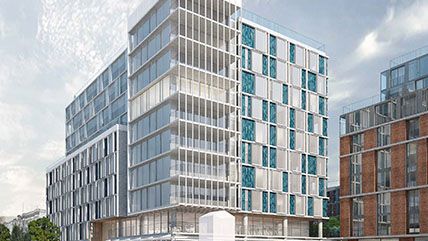Yes In My Backyard
San Francisco activists push for more construction in Baghdad by the Bay.


"Cities are incredible things," says activist Sonja Trauss. "They're places where freedom is possible in a way that is just not as possible in a small town. So I feel like San Francisco and the Bay Area should be taking advantage of its opportunity to build a big city."
But San Francisco isn't getting that much bigger—at least in terms of places to live. In 2015, the Bay area added 64,000 jobs but less than 5,000 residential units.
One of the reasons for the housing shortfall is the existence of NIMBY ("not in my backyard") groups that have been able to successfully organize against development in the region. That in turn has sparked a countermovement of YIMBY ("yes in my backyard") groups that believe the solution is to build, build, build.
Trauss, who founded the San Francisco Bay Area Renters' Federation (yes, the acronym is SF BARF), is one of this movement's more visible members. The problem she's combatting lies in the city's unique regulatory culture that allows neighbors to weigh in, and often veto, new construction they deem a nuisance. "We are embarking on a public conversation about property rights and where they should be situated," Trauss says. "Currently…you can't do that much to your property, but you have a lot of control over everyone else's around you. We want to switch the regime."
Some of the recent developments delayed by NIMBY opponents include a 36-story residential building at 1481 Post Street that was first proposed over 10 years ago; a 17-acre space at Balboa Reservoir that is currently an empty parking lot; and a 10-story condo development at 1979 Mission Street that residents have dubbed the "monster in the Mission." In 2010, residents banded together to block the addition of high-speed internet equipment around the city, with some claiming a broadband antenna could "accidentally zap residents with concentrated radio waves" in the event of an earthquake.
Besides the NIMBYs, developers face another major opposition force in San Francisco: well-intentioned progressives who want to help the poor by allowing only certain kinds of housing to be built. These activists worry that new luxury developments will mean even higher rent prices that displace existing communities.
But many experts are skeptical of this logic. The California Legislative Analyst's Office, a nonpartisan office that provides policy and budget recommendations to lawmakers, concluded that "considerable evidence suggests that construction of market-rate housing reduces housing costs for low-income households and, consequently, helps to mitigate displacement in many cases."
Why would building more luxury condos be good for regular people? Because shortages lead to skyrocketing real estate prices. The median home in San Francisco is now over the million-dollar mark, and an average one-bedroom apartment rents for more than $3,500 a month. It's a classic case of supply and demand: With more people moving to the region, there's more competition for the existing units. And when there's competition, the rich nearly always win.
In May, Trauss went to Sacramento to lobby in support of a proposal from Democratic Gov. Jerry Brown that would streamline the permitting process for new development that meets affordable housing requirements and prevent NIMBYs from stalling future projects.
The first national YIMBY conference also took place in Colorado over the summer. Trauss, who was a keynote speaker at the event, says her goal is to export the YIMBY platform to other cities and to create rules that lean in favor of the landowner. Officials, she explains, need to be asking, "What is the property rights regime that protects people and helps people protect themselves?"
This article originally appeared in print under the headline "Yes In My Backyard."


Hide Comments (0)
Editor's Note: As of February 29, 2024, commenting privileges on reason.com posts are limited to Reason Plus subscribers. Past commenters are grandfathered in for a temporary period. Subscribe here to preserve your ability to comment. Your Reason Plus subscription also gives you an ad-free version of reason.com, along with full access to the digital edition and archives of Reason magazine. We request that comments be civil and on-topic. We do not moderate or assume any responsibility for comments, which are owned by the readers who post them. Comments do not represent the views of reason.com or Reason Foundation. We reserve the right to delete any comment and ban commenters for any reason at any time. Comments may only be edited within 5 minutes of posting. Report abuses.
Please to post comments
Mute this user?
Ban this user?
Un-ban this user?
Nuke this user?
Un-nuke this user?
Flag this comment?
Un-flag this comment?